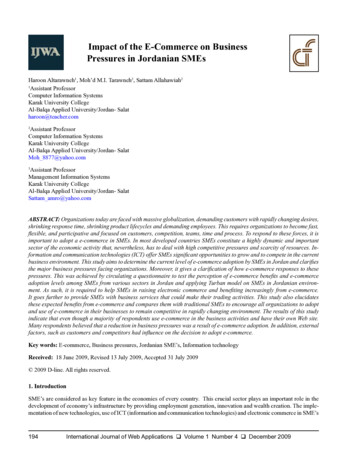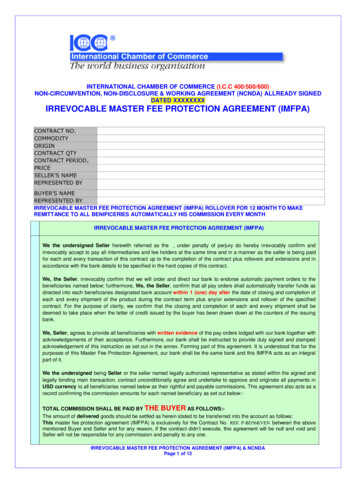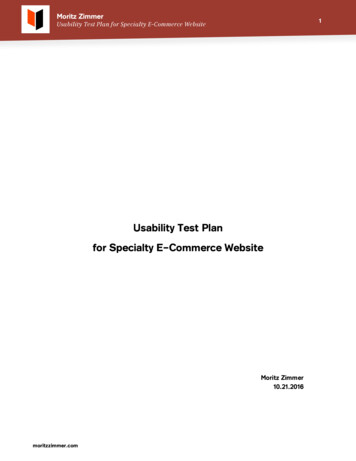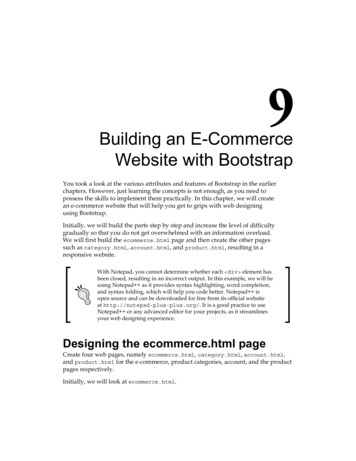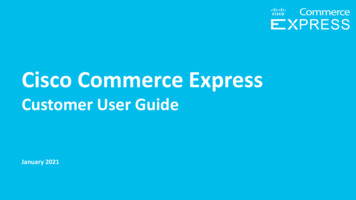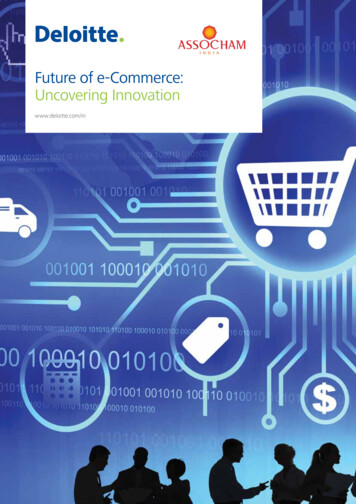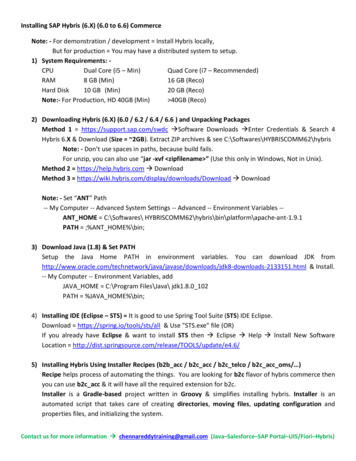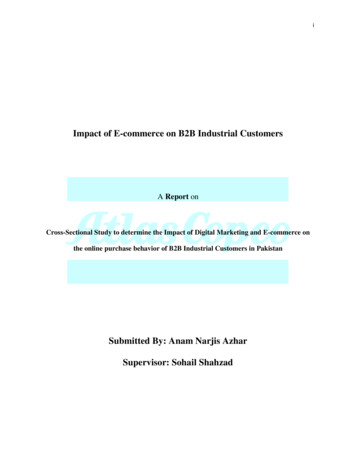
Transcription
iImpact of E-commerce on B2B Industrial CustomersA Report onCross-Sectional Study to determine the Impact of Digital Marketing and E-commerce onthe online purchase behavior of B2B Industrial Customers in PakistanSubmitted By: Anam Narjis AzharSupervisor: Sohail Shahzad
iiAbstractThe internet has been observed to change the way humans interact with one another incontemporary times. This increase in the use of the internet across the world has allowed ecommerce to boom overall. This paper intends to find a similar impact of the internet and ecommerce on the online purchasing behavior of B2B industrial customers in Pakistan with a crosssectional study conducted with the help of Atlas Copco Pakistan. The study shows that ecommerce has indeed penetrated in Pakistan with huge opportunities for B2B firms to grow andprosper in Pakistan if digital marketing strategies are efficiently chosen and implemented. B2Bbuyers in Pakistan have shifted towards more modernized means of purchasing for their businessneeds, i.e. e-commerce.
iiiTable of Contents12CHAPTER 1 . 61.1.Introduction . 61.2.Background of the Project . 81.3.Objectives of the Project . 91.4.Significance of the Project. 10CHAPTER 2 . 11Literature Review . 112.1 B2B Customers and Digital Marketing . 112.2 B2B E-commerce Marketplace . 132.3 Achieving Market Excellence by E-commerce . 162.4 Internet presence for B2B Marketers . 182.5 Online Channels . 192.6 Customer Data Privacy in the Digital Era . 222.7 A Shifting Trend and Pakistan . 232.8 Atlas Copco: A Leading B2B E-commerce Player in Pakistan. 26CHAPTER 3 . 283.1Research Methodology . 293.2 Hypothesis. 293.2 Type of Research Study . 303.3 Methodology . 303.4 Data Collection Sources . 303.5 Data Collection Tools . 313.6 Participants . 313.7 Data Processing and Analysis Techniques. 32CHAPTER 4 . 33Data Analysis . 33Summary. 44CHAPTER 5 . 46Conclusion . 46
ivRecommendations . 47Limitations . 48References . 49Appendix . 54
vList of IllustrationFigure 1: Sales in billion U.S. dollars – (Clement, 2019) . 14Figure 2: B2B e-commerce volume in billion U.S. dollars – (Gensen, n.d.) . .19Figure 3: 10 largest e-commerce markets in the world (by billion USD) – (Osman, 2019) . 20Figure 4: Payment Methods offered to Business Customers – (Gensen, n.d.) . 24Figure 5: Shifting trend from B2C to B2B – (Meghani, 2018) . 27Figure 6: Online orders from Business Customers – (Gensen, n.d.) . .16Figure 7: E-Commerce; Value and The Journey - (Sharma, 2002) . .21Figure 8: Global Digital Population (Millions) – (Clement, 2019) 17Figure 9: Number of Social Media Users - (Clement, 2019) .23Figure 10: Way to Market and the Sales Process - (Atlas Copco Pakistan) .32Figure 11: Age of B2B Industrial Customers .36Figure 12: Preference for Purchasing in Pakistan .37Figure 13: Type of Purchase in Pakistan 39Figure 14: Medium of Online Purchase in Pakistan .39Figure 15: Buying Power of B2B Industrial Customers in Pakistan .40Figure 16: Payment Method in Pakistan .42Figure 17: Behavior of B2B Industrial Customers in Pakistan (1) .43Figure 18: Functionalities in Websites for Online Purchase 44Figure 19: Behavior of B2B Industrial Customers in Pakistan (2) .45
61 CHAPTER 11.1. IntroductionWith the dawn of the technological revolution 4.0, firms have started to focus more on digitalmarketing strategies as compared to old-fashioned and traditional marketing strategies throughprint media. This sort of marketing has enabled firms across the globe to attract even morecustomers than they could imagine because of the ever-growing vast internet community. Theincreasing trend of digital marketing has also encompassed the B2B industrial sector in it alongwith the B2C sector. B2B firms have started to use extensive digital marketing campaigns to attracttheir sophisticated business customers through inbound marketing, e-commerce marketingcombined with business analytics. This trend of B2B digital marketing is not limited to developedcountries such as the United States of America, China or India but also has started to make its waytowards developing countries as well such as Pakistan, Malaysia, and Indonesia. The rise in theinternet and smartphone penetration rate in Asia Pacific countries has been remarkable to say theleast. Pakistan is one of those countries in the Asia Pacific region which has shown the mostresponse towards this changing trend. As a result, buyer personas are starting to change with theirincreased reliance on the internet as a medium of information and decision making. It has beenobserved that B2B firms in Pakistan such as Atlas Copco Pakistan along with Tetra Pack and othercompanies have started to capitalize on this changing trend as they have changed the focus of theirmarketing strategies towards e-commerce. This shift in strategy has enabled them to capture thelarge e-commerce marketplace along with an increase in competition and efficient allocation ofresources. The traditional price, promotion, product, and place marketing strategy has now beenrevolutionized thanks to the rise of e-commerce. This paper attempts to analyze this shift in the
7online purchasing behavior of B2B industrial customers in Pakistan with an extensive crosssectional study.
81.2. Background of the ProjectThe rising trends towards digitization across the globe, including both developed and underdeveloped countries, has opened a gate of endless opportunities for business organizations. Thepenetration of internet and social media platforms in the day-to-day activities of industrialcustomers across the globe has resulted in tremendous opportunities for B2B firms to increase theircustomer base. The use of the internet and social media platforms as online channels to runeffective marketing campaigns has helped businesses to grow across the globe. This paper aims inassessing the possibility of a similar e-commerce boom in Pakistan with a cross-sectional study. Italso identifies, whether the online purchasing behavior of B2B industrial customers has changedin Pakistan with the rapid penetration of the internet and e-commerce.
91.3. Objectives of the ProjectThe primary objective of this paper is to analyze the impact of e-commerce in the Pakistan’sindustrial market and to show that Pakistan is now at an inception period from where it wouldbegin its journey of business to business e-commerce revolution as has happened in moredeveloped countries such as the United States of America and China along with the rest of theworld. This paper aims to use a cross-sectional study methodology conducted with the help ofAtlas Copco Pakistan’s customer relationship management software. The objectives of this paperinclude finding out any sign of a shift from traditional buying practices to more e-commercespecific buying practices with the rise of digital marketing strategies among the B2B industrialcustomer segment of Pakistan. This paper also aims to prove the rising use of the internet andsocial media platforms in Pakistan while offering a promising opportunity for B2B firms toincrease their inflow of leads and mature inquiries through digital marketing.
101.4. Significance of the ProjectThe significance of this project can be assessed by the fact that in the modern age, 73% of B2Bindustrial customers search on Google for decision-making purposes regarding their B2Bindustrial purchases. Besides, 57% of customer’s decisions are already made through viewingand self-analyzing online advertisements and product features. It has been reported that acustomer makes 12 unique searches before they contact a company to purchase any onlineproduct or service. Hence, the effective use of digital media for lead generation is highlyimportant since the internet has now become a major decision-making factor for B2B industrialcustomers. A recent study found that millennials B2B buyers are not just coming, they arealready here. 41% of millennials are either making purchasing decisions or influencing them.Further, 38% are tasked with researching purchases; however, 82% are part of the buyingcommittee in some capacity. Since the use of the internet and social media platforms are mostcommon by Millenniums, hence, there is an increased need for B2B firms to capture thisemerging trend, rising with the e-commerce revolution, with the use of effective digitalmarketing strategies.Keeping in mind the above-mentioned change in the buying behavior of Millenniums with therise of e-commerce, this paper aims to study the effect of undergoing B2B e-commerce drivein Pakistan which would greatly benefit the industrial market through digital marketingintegration.
11CHAPTER 2Literature Review2.1 B2B Customers and Digital MarketingB2B or Business-to-Business customers, also known as industrial or business customers, are thosecustomers that buy products and services from other businesses and then use these products orservices in their own businesses. B2B firms and customers function across different sectors of theeconomy including but not limited to manufacturing, fintech, construction, communication,agriculture, and transport. The importance of B2B customers for firms can be gauged by the factthat B2B market size is approximately 4 times the market size of B2C customers with an estimatedB2B e-commerce market size of 12.2 trillion in 2019 across the globe. Out of the 12.2 trillion,Asia-Pacific countries have a market share of 80%, which shows the huge potential of countriessuch as China, Pakistan, and India in the B2B marketplace (Hamke & Mehta, 2019). Compared tothis, B2C e-commerce market size across the globe was just 3.535 trillion in 2019 as shown inFigure 1 (Clement, 2019). This huge potential in the B2B marketplace derives firms to investmillions of dollars in their marketing budgets. However, firms need to be careful while theformulation of their marketing strategies based on their target audience, i.e., B2B or B2Ccustomers.
12Figure 1: Sales in billion U.S. dollars – (Clement, 2019)With the advent of technological advancements, the role of the internet and technology in the B2Bmarketplace has become more important than ever. Businesses have started to use the internet asa medium of marketing to drive more customers and buyers towards their doorstep with differentonline marketing advertisement campaigns on social media platforms such as Facebook, Twitter,LinkedIn, and Instagram among others. According to the Interactive Advertising Bureau reportprepared by PricewaterhouseCoopers, digital revenues coming from internet advertisements forbusinesses were about 107.5 billion in the fiscal year 2019 with B2B revenues crossing 26.2billion alone (IAB/PWC, 2019). Therefore, “by bringing companies and customers together, theInternet thus promises to widen markets, increase efficiencies, and lower costs” (Evans and King,1999). The use of internet using digital channels such as mobile phones, display advertising, social
13media marketing, e-commerce marketing, and search engine marketing can be termed as digitalmarketing, which is being increasingly used by B2B organizations in order to enhance theircustomer outreach in a cost-efficient manner (Yasmin, Tasneem & Fatema, 2015). This sort ofdigital presence has its own benefits for businesses such as improved information gathering andfeedback, increased knowledge, internal and external relationships, supports decision-makingprocess, increased productivity, and better outcome measures (Tiago & Veríssimo, 2014). Animportant aspect of digital marketing is e-commerce marketing which will be discussed in the nextsection of this chapter.2.1 B2B E-commerce MarketplaceE-commerce or ”electronic commerce involves the undertaking of normal commercial,government, or personal activities by means of computers and telecommunications networks; andincludes a wide variety of activities involving the exchange of information, data, or value-basedexchanges between two or more parties” (Chan & Swatman, 2000). With the advent of the digitalera, e-commerce has become an internal part of any firm’s business and marketing strategy. Let’sbe clear about one thing, e-commerce is not limited to B2C firms only but also includes a largenumber of B2B firms that go against the general conception that B2B firms are more dependenton the traditional means of business rather than e-commerce. Contrary to this misconception,around 78% of the B2B retailers reported that they have been using e-commerce as a mean ofselling online products and services for the last 2-5 years with only 10% of the retailers digitallyactive for less than 6 months as shown in Figure 6 (Gensen, n.d.).
14Figure 6: Online orders from Business Customers – (Gensen, n.d.)Industrial companies such as Atlas Copco, Tetra Pack, Ericsson, General Electric, and Volvo havebeen on a growth trajectory because of the use of e-commerce, which enables them to managetheir sales and costs efficiently. Other major players across the globe include Alibaba, IndiaMart,eWorldTrade, ThomasNet, Global Source, EC21, and Intel. Without a doubt, Alibaba is leadingthe global B2B e-commerce war having a market value of 140 billion and an estimated IPO valueof 15 billion. The ease of attracting new and old customers using digital marketing and ecommerce strategies can be gauged by the fact that on average, 18 million customers visiteWorldTrade every month. Similarly, Global Source, a publicly listed company on NASDAQ, hadsales of around 231.7 million in 2012 with the credit going to e-commerce (Ilyas, 2018).Similarly, ABB, a Swedish automation company, has gone the extra mile in e-commerce as it hasbeen selling circuit breakers, dual-power transfer switches, power quality products, industrialcontrol products, building intercom systems, and intelligent construction control systems.
15Furthermore, “Ericsson announced that Ericsson Wallet Platform 3.0 has obtained certification forthe Payment Card Industry (PCI) Security Standards Council’s Payment Application Data SecurityStandard (PA-DSS v3.0) (Ericsson Wallet, 2015).” It is estimated that an average sales andcustomer service representative spends on average 20 minutes on the phone per order, which is ahuge drain on company resources. The use of technology and e-commerce marketing strategies bybusiness executives can save such valuable resources which can then be optimally used in someother function of the business. Furthermore, the potential of reaching such a large number ofcustomers across the globe at minimal costs definitely gives an incentive to B2B firms for investingin digital and e-commerce marketing. According to estimates, nearly 4.48 billion people used theinternet in one way or another in just October 2019 making up almost 58% of the worldwidepopulation as shown in Figure 8 (Clement, 2019). Out of these 58% worldwide internet users, AsiaPacific countries including China, India, and Pakistan are leading the e-commerce marketplacealong with the United States of America.Figure 8: Global Digital Population (Millions) – (Clement, 2019)
162.3 Achieving Market Excellence by E-commerceIn order to capitalize on the benefits offered by e-commerce, many companies have shifted theirbusiness strategies towards e-commerce centric marketing strategies. “E-commerce marketing isthe practice of using promotional tactics to drive traffic to your online store, converting that trafficinto paying customers, and retaining those customers post-purchase (Wang, 2018).” E-commercemarketing strategies in the digital era involves the promotion (through online channels) of products(content being sold) sold at standard prices at different places (using internet infrastructure andcontext) (
8 1.2. Background of the Project The rising trends towards digitization across the globe, including both developed and under-developed countries, has opened a gate of
